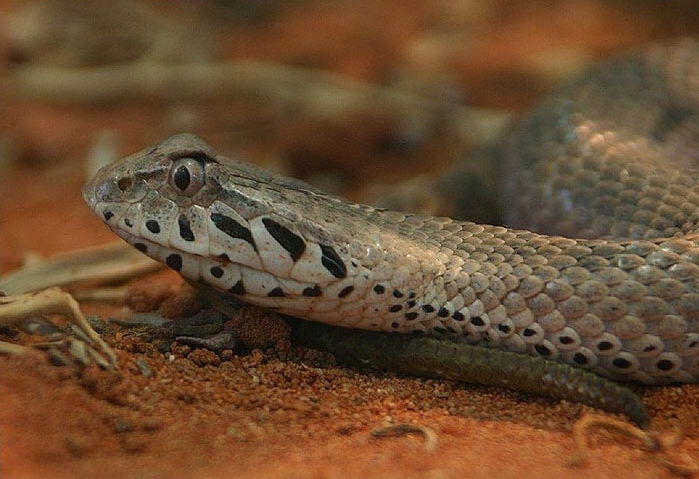Common Death Adder (Acanthophis antarcticus) - Wiki Common Death Adder
From Wikipedia, the free encyclopedia
[Photo] Common Death Adder (Acanthophis antarcticus) at Rheinberger Terra-Zoo. Photographer: Petra Karstedt / www.Tiermotive.de Date 12-Jul-2006. Author Petra Karstedt
The Common Death Adder (Acanthophis antarcticus), is a species of Death Adder native to Australia. It is one of the most venomous land snakes in Australia and the world. Unlike its sister species of Death Adders, the Common Death Adder is common and is not under major threat.
Description
Common Death Adders have broad flattened, triangular heads and thin bodies. Reaching a length of 70-100 centimetres, they are light brown with dull, darker brown-black stripes running horizontally across their bodies. Their fangs are longer than most of Australia’s venomous snakes.
Distribution
The Common Death Adder occurs over much of eastern and coastal southern Australia - Queensland, New South Wales, Victoria and South Australia. It may also be found more scarce in the Northern Territory, Western Australia and the west parts of South Australia, due to its sister species of Death Adders (eg. Desert Adder).
Habitat
Common Death Adders are found in forests, woodlands, grasslands and heaths of the Eastern Coast of Australia. It is a master of camouflage, due to its band stripes, hiding beneath loose leaf litter and debris in woodland, shrubland and grassland.
Behaviour
Diet
Common Death Adders eat small mammals and birds as a primary diet. Unlike other snakes, the Common Death Adder lies in wait for its prey (often for many days) until a meal passes. It covers itself with leaves - making itself inconspicuous - and lies coiled in ambush, twitching its yellowish grub-like tail close to its head as a lure. When an animal approaches to investigate the movement, the death adder quickly strikes, injecting its venom and then waiting for the victim to die before eating it. This ambush hunting makes the death adder more of a threat to humans.
Reproduction
Unlike most snakes, Death Adders produce litters of live young. In the late summer, a female Death Adder will produce a litter of live babies, approximately 10-20, however over 30 young have been recorded in a single litter.
Venom
The Common Death Adder is the world's fifth most venomous snake and probably the fastest of all Australian snakes when it comes to striking a victim. However, Death Adders are reluctant to bite and can often be greatly harassed before striking.
http://en.wikipedia.org/wiki/Common_Death_Adder
| The text in this page is based on the copyrighted Wikipedia article shown in above URL. It is used under the GNU Free Documentation License. You may redistribute it, verbatim or modified, providing that you comply with the terms of the GFDL. |
